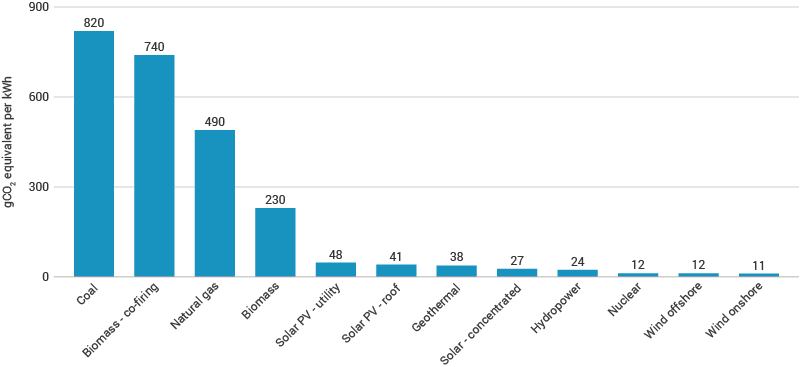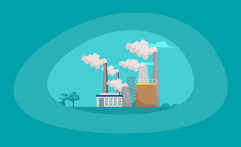What Is the Carbon Footprint of Nuclear Power? A Life-Cycle Assessment
Impactful Ninja is reader-supported. When you buy through links on our site, we may earn an affiliate commission.
Learn more
Learn more
.
Hey fellow impactful ninja ? You may have noticed that Impactful Ninja is all about providing helpful information to make a positive impact on the world and society. And that we love to link back to where we found all the information for each of our posts. Most of these links are informational-based for you to check out their primary sources with one click. But some of these links are so-called "affiliate links" to products that we recommend. First and foremost, because we believe that they add value to you. For example, when we wrote a post about the environmental impact of long showers, we came across an EPA recommendation to use WaterSense showerheads. So we linked to where you can find them. Or, for many of our posts, we also link to our favorite books on that topic so that you can get a much more holistic overview than one single blog post could provide. And when there is an affiliate program for these products, we sign up for it. For example, as Amazon Associates, we earn from qualifying purchases. First, and most importantly, we still only recommend products that we believe add value for you. When you buy something through one of our affiliate links, we may earn a small commission - but at no additional costs to you. And when you buy something through a link that is not an affiliate link, we won’t receive any commission but we’ll still be happy to have helped you. When we find products that we believe add value to you and the seller has an affiliate program, we sign up for it. When you buy something through one of our affiliate links, we may earn a small commission (at no extra costs to you). And at this point in time, all money is reinvested in sharing the most helpful content with you. This includes all operating costs for running this site and the content creation itself. You may have noticed by the way Impactful Ninja is operated that money is not the driving factor behind it. It is a passion project of mine and I love to share helpful information with you to make a positive impact on the world and society. However, it's a project in that I invest a lot of time and also quite some money. Eventually, my dream is to one day turn this passion project into my full-time job and provide even more helpful information. But that's still a long time to go. Stay impactful,Affiliate Disclosure
Why do we add these product links?
What do these affiliate links mean for you?
What do these affiliate links mean for us?
What does this mean for me personally?
![]()
Nuclear power uses radioactive material to produce electricity. Although the operation of nuclear power does not produce carbon dioxide (CO2) emissions, emissions can still be found during other stages of its life cycle. So, we had to ask: What is the carbon footprint of nuclear power?
Nuclear power has the third-lowest carbon footprint of all energy types. Per kWh produced, nuclear power emits 12 grams of CO2 on a life-cycle basis. It combats climate change and has various environmental benefits, but comes with the threat of nuclear waste products.
Keep reading to learn about the overall carbon footprint of nuclear power and its carbon footprint throughout its life cycle.
How is Nuclear Power Defined
In general, nuclear power is generated when neutrons either divide or fuse, which releases heat, produces steam, spins a turbine, and drives generators to produce electricity. The two ways we can generate nuclear power are via nuclear fission (when neutrons divide) or nuclear fusion (when neutrons fuse).
This means that the carbon footprint of nuclear power is the carbon footprint of both nuclear fission and nuclear fusion.
Nuclear fission is the generation of energy produced when splitting apart the nucleus of an atom.
“Nuclear fission: a nuclear reaction in which a heavy nucleus splits spontaneously or on impact with another particle, with the release of energy.”
Cambridge Dictionary
Nuclear fusion is the generation of energy produced when lighter atoms are combined or fused to create larger and heavier atoms.
“Nuclear fusion: the process of joining two nuclei to produce energy.”
Cambridge Dictionary
All operating nuclear power plants today utilize the process of nuclear fission, whereas nuclear fusion is still very much in the research and development phase.
What is the Carbon Footprint of Nuclear Power
The carbon footprint is one of the ways we measure the effects of human-induced global climate change. It primarily focuses on the greenhouse gas (GHG) emissions associated with consumption, but also includes other emissions such as methane, nitrous oxide, and chlorofluorocarbons.
“Carbon footprint: the amount of greenhouse gases and specifically carbon dioxide emitted by something (such as a person’s activities or a product’s manufacture and transport) during a given period”
Merriam Webster
Basically, it is the amount of carbon emitted by an activity or an organization. This includes GHG emissions from fuel that we burn directly (e.g., heating a home, driving a car) and GHG emissions from manufacturing the products that we use (e.g., power plants, factories, and landfills).
What Is the Overall Carbon Footprint of Nuclear Power
All operating nuclear power plants today utilize the process of nuclear fission. Because of this, nuclear fission is commonly referred to as ‘nuclear power’ in the data and literature.
On a life-cycle basis, nuclear power emits 12 grams of CO2 equivalent per kilowatt-hour (kWh) of electricity produced, which is tied for the third-lowest out of all energy types.

Nuclear fusion also produces little to no greenhouse gas emissions and toxic byproducts, making it one of our most environmentally friendly energy sources. One study on tokamak fusion power plants found that they emit less CO2 than photovoltaic solar systems and less than double those from nuclear fission reactors.
There are currently more than 10 stellarators and 50 tokamaks in operation worldwide, but there are currently no operating fusion reactors providing energy to our power grid. The focus remains on overcoming the two main challenges to nuclear fusion: keeping the reaction going and generating more energy from the reaction than was required to start the reaction.
To understand the carbon footprint of nuclear power, we must assess its life-cycle and each stage’s carbon footprint. This life-cycle assessment (LCA) is a method to evaluate the environmental impacts of products and materials. Over the years, companies have strategically used LCA to research and create more sustainable products. So, let’s have a look at the LCA of nuclear power!
| The life-cycle stages of nuclear power | Each stage’s carbon footprint |
| Building of nuclear power | Some CO2 emissions from constructing the nuclear power plant, mining and processing uranium, transporting nuclear fuel to the power plant |
| Operating of nuclear power | Little to no CO2 emissions or waste products |
| Building back of nuclear power | Some CO2 emissions from transporting used fuel/radioactive material and deconstructing the power plants |
The total carbon footprint of nuclear power would equal the carbon footprint from building + the carbon footprint from operating + the carbon footprint from building back.
What Is the Carbon Footprint of Building Nuclear Power
The carbon footprint of building nuclear power includes constructing the power plant, mining and processing the uranium, and transporting the processed nuclear fuel to the power plant.
A nuclear power plant has many components, and building these components requires machinery that emits CO2. For nuclear fission, the containment building, reactor vessel, steam lines, pumps, turbines, generators, transformers, and cooling towers are all components with a carbon footprint. And nuclear fusion reactors can consist of millions of components including, but not limited to, magnets, coils, antennas, diagnostic instruments, cryopumps, thermal shields, and beam injectors, all of which have a carbon footprint of their own.
Nuclear fission comes with the additional steps of: mining the Uranium, milling (extracting) it from the surrounding ore, centrifuging the milled uranium until the two isotopes (Uranium-238 and Uranium-235) separate, and forming the pellets of fission reactor fuel, all of which are processes that produce emissions.
What Is the Carbon Footprint of Operating Nuclear Power
Nuclear reactors, both fission and fusion, do not produce any CO2 emissions in the operating phase because there is no burning of fossil fuels or combustion byproducts.
Nuclear fission power plants generally operate in the following manner:
- The reactor starts and U-235 atoms in the reactor core split (fission), releasing heat and neutrons.
- Neutrons fission other nuclei in the reactor core in a chain reaction, generating more heat and more neutrons.
- Control rods contain materials that absorb some of the neutrons, helping to contain the chain reaction.
- The heat generated turns water that surrounds the immersed reactor into steam.
- The steam spins a turbine which drives a generator to produce electricity.
Nuclear fusion power plants generally operate in the following manner:
- Deuterium and tritium (isotopes of hydrogen) are introduced into a fusion reactor and heated upwards of 150 million degrees Celsius
- The deuterium and tritium fuse together, forming an electrically charged gas known as plasma and releasing massive amounts of energy and neutrons
- A lithium blanket surrounding the core of the fusion reactor absorbs the kinetic energy of the neutrons, causing the blanket to heat up
- As the blanket heats up, the lithium is transformed into tritium (which is used to fuel the reaction) and helium
- The energy, in the form of heat, is collected by the coolant (water, helium, or Li-Pb eutectic) flowing through the blanket
- The heat can be used to generate electricity
What Is the Carbon Footprint of Building Back Nuclear Power
The organizations tasked with deregulating and decommissioning nuclear fission power plants vary from country-to-country. For example, the US Nuclear Regulatory Commission is responsible for overseeing the decommissioning of nuclear fission power plants in the US.
In general, the process of shutting down nuclear fission plants is expensive, labor-intensive, time-consuming, and comes with health and safety risks. The entire process can take up to 60 years.
Decommissioning a nuclear fission power plant generally involves the following steps:
- Removing and storing spent nuclear fuel rods in spent fuel pools
- Decontaminating the plant
- Reducing residual radioactivity at the plant
- Dismantling plant structures
- Transferring contaminated materials to disposal facilities
- Clearing the site for other uses
Because nuclear fusion has not yet achieved commercial viability, there is no data involving the decommissioning of nuclear fusion reactors or power plants.
The fuel for fusion reactions, deuterium and tritium, are easily accessible. Deuterium can be extracted from seawater, and tritium can be produced inside tokamak reactors when plasma comes into contact with the lithium blanket. Because the fuel is virtually inexhaustible, this means nuclear fusion reactions could theoretically always be generated (under the right conditions).
Building back nuclear power involves CO2 emissions associated with transporting used fuel and radioactive material, deconstructing the plant/reactor, and repurposing the site.
What Role Does Nuclear Power Play in Combating Climate Change
Climate change is arguably the most severe, long-term, global impact of fossil fuel combustion. Every year, approximately 33 billion tons (bt) of CO2 are emitted from burning fossil fuels. The carbon found in fossil fuels reacts with oxygen in the air to produce CO2. This warms the earth by acting as a heating blanket, and a warmer earth comes with a host of negative side effects.
Using nuclear power to produce energy instead of fossil fuel energy helps mitigate the following negative effects of climate change:
- Increasing temperatures: Earth’s atmosphere has warmed 1.5℃ since 1880. This may not seem like a lot, but these degrees create regional and seasonal temperature extremes, reduce sea ice, intensify rainfall and drought severity, and change habitat ranges for plants and animals.
- Rising sea levels: Global sea levels have increased approximately 8-9 inches since 1880, displacing people living along coastlines and destroying coastal habitats. Roads, bridges, subways, water supplies, oil and gas wells, power plants, sewage treatment plants, and landfills remain at risk if sea level rise goes unchecked.
- Melting of sea ice: Since 1979, arctic sea ice has declined by 30%. Sea ice plays a major role in regulating the earth’s climate by reflecting sunlight into space and providing habitat for animal species. If all of the glaciers on Earth melted, sea levels would rise by approximately 70 feet, effectively flooding out every coastal city on the planet.
- Changing precipitation patterns: Extreme weather events (e.g., hurricanes, floods, droughts) are becoming more common and more intense. Storm-affected areas will experience increased precipitation and flooding whereas areas located further from storm tracks will experience decreased precipitation and droughts.
- Ocean acidification: The ocean absorbs 30% of the CO2 released into the atmosphere, which decreases the pH (increases the acidity) of the ocean. In the past 200 years, the pH of oceans has decreased by 0.1 pH units, which translates to a 30% increase in acidity. Aquatic life unable to adjust to this rapid acidification will die off. A prime example of this is coral bleaching, where coral expels the algae (zooxanthellae) living in their tissues as a result of changes in temperature, light, or nutrients.
The more we reduce CO2 emissions, the more we slow the rate of temperature rise, sea-level rise, ice melting, and ocean acidification. When these rates are slowed, the earth’s biodiversity does not have to struggle to adapt to temperature and pH changes. People will not be displaced due to the flooding of coastal areas. And icebergs will continue to provide climate regulation.
Most experts agree that we are unlikely to achieve large-scale nuclear fusion energy generation before 2050. This means that fusion is not an option for meeting the short-term climate goals laid out in The Paris Climate Agreement, which aims to limit global warming to below 2 degrees Celsius (C).
How Environmentally Friendly Is Nuclear Power
The overall environmental friendliness of nuclear power is a controversial topic.
“Environmentally friendly: (of products) not harming the environment.”
Cambridge Dictionary
Although the process of nuclear fission produces zero CO2 emissions, the handling and disposal of nuclear waste is a serious issue. On the other hand, experts tout nuclear fusion as a clean, safe, reliable, and environmentally friendly energy source.
What Are The Environmental Benefits of Nuclear Power
Nuclear power is expected to continue to play a key role in the clean energy movement. This is because nuclear power:
- Has a low carbon footprint: Nuclear fission has an average life-cycle CO2 equivalent emission value that is much less than coal, 12g of CO2 equivalent per kWh compared to 820g of CO2 equivalent per kWh, respectively. Nuclear fusion produces little to no greenhouse gas emissions and toxic byproducts, making it one of our most environmentally friendly sources of energy.
- Has a minimal land use impact: Nuclear fission produces more electricity on less land than any other clean-air source. A standard, 1,000-megawatt nuclear fission facility requires only a little more than 1 square mile to operate, a number that is 360 and 75 times less than what is required for wind farms and solar power plants, respectively.
- Is energy dense: Nuclear fuel is extremely dense, so you don’t need a lot of it to create a lot of energy. One U-235 pellet 1 inch tall is the equivalent of 1 ton of coal and directly avoids the emission of over 2 tons of CO2 from our atmosphere. In addition, in theory, it is possible to produce one terajoule of nuclear fusion energy with just a few grams each of Deuterium and tritium. This would be enough to meet the needs of an adult person living in the developed world for 60 years.
- Generates very little waste: A typical 1,000-megawatt nuclear fission facility produces only three cubic meters of nuclear waste. In comparison, the average coal-fired power plant produces roughly 300,000 tons of coal ash and more than 6 million tons of CO2 every year. Nuclear fusion produces minimal short and medium-term nuclear waste byproducts.
- Promotes energy security: Nuclear power contributes to energy security by increasing the stability of our power grids. Unlike renewable energy, which faces variations in supply and demand, nuclear power can provide a reliable and consistent source of clean energy.
- Promotes energy independence: Being able to produce your own electricity without the aid of foreign countries is an important step in becoming self-sufficient. For example, former President George W. Bush signed the Energy Independence and Security Act of 2007 to reduce US dependence on oil, expand the production of renewable fuels (and confront global climate change).
- Creates jobs: In the US alone, the nuclear industry employs 100,000 people directly and 475,000 jobs secondarily. Because there are 60 reactors under construction currently and 110 more are being planned, the number of jobs is expected to continue to increase globally.
In addition, nuclear fusion comes with the following additional benefits:
- Uses readily available materials: The nuclear fusion reaction is most readily feasible between deuterium and tritium, two isotopes of hydrogen. Deuterium is naturally abundant in seawater, and tritium can be bred from lithium, which is naturally abundant in the Earth’s crust and in seawater. Compare this to Uranium-235, the ingredient for nuclear fission, which has a concentration of only 2.8 parts per million (0.7% abundance) in the Earth’s crust.
- Does not produce long-lived nuclear waste: Unlike nuclear fission, nuclear fusion reactions do not produce long-lived nuclear waste. The only byproducts are helium (an inert gas) and tritium. Although tritium is radioactive, it is produced and consumed within the plant in a closed circuit and is only used in low amounts.
- Cannot cause a nuclear accident: Unlike nuclear fission, nuclear fusion reactions are not based on chain reactions. Plasma must be kept at very high temperatures and pressures, with the support of external heating systems and magnetic fields. If there is a loss of pressure or temperature, the reactor shuts down with no adverse effects to the outside world.
- Cannot be used to produce nuclear weapons: Hydrogen bombs do use fusion reactions; however, they require an additional nuclear fission bomb to detonate. Fusion fuel is also continuously injected and consumed in fusion reactors, so there is never enough fuel lying around to produce a weapon.
What Are The Environmental Drawbacks of Nuclear Power
Nuclear power does come with some drawbacks that, if handled properly, can be mitigated. The main environmental drawbacks associated with nuclear power are associated with nuclear fission and include:
- Uranium mining: This process contaminates the environment with radioactive dust, radon gas, water-borne toxins, and increased levels of background radiation. Exploratory drilling and mining also heavily increases the risk of water contamination.
- Long-lived nuclear waste: Although nuclear power produces minimal waste, the waste that it does produce is radioactive and can remain hazardous for many thousands of years. These radioactive waste products include uranium mill tailings, spent (used) reactor fuel, and other radioactive wastes. If these were to leach into the environment it could contaminate the soil and water.
Unlike nuclear fission, nuclear fusion does not generate long-lived radioactive waste. However, experts have noted that nuclear fusion can produce short- to medium-term radioactive waste. Component materials constantly bombarded by neutrons will become radioactive over time and generate nuclear waste. The amount of waste would be comparable to waste generated by nuclear fission, but nuclear fusions’ waste is less radioactive in the long term.
In addition, tritium is weakly radioactive. If tritium were leaked into the environment, it could be difficult to contain given that it can penetrate concrete and rubber. It is also easily incorporated into water and can make water weakly radioactive. Tritium has a half-life of roughly 12 years, meaning it could persist up to 125 years after it is created.
Although tritium is radioactive, it is produced and consumed within the plant in a closed circuit and is only used in low amounts. Still, the possibility of leaks has spurred research into deuterium-deuterium fusion, because deuterium is not radioactive.
Final Thoughts
Nuclear power is an incredibly efficient energy source that uses heat acquired from splitting the nuclei of atoms to create electricity. The process of nuclear fission does not produce CO2 emissions, but the construction of the power plant, mining and transportation of uranium, and deconstruction of the power plant are all areas that have carbon footprints.
Nuclear power benefits the environment by mitigating climate change, creating jobs, promoting energy independence, and protecting air quality. Environmental drawbacks including mining and nuclear waste can be mitigated with proper handling and disposal methods.
Stay impactful,

Sources
- Impactful Ninja: Nuclear Power Explained – All You Need to Know
- The International Atomic Energy Agency: What is Nuclear Energy? The Science of Nuclear Power
- World Nuclear Association: Nuclear Fusion
- Britannica: Carbon Footprint
- United States Environmental Protection Agency: System of Registries
- World Nuclear Association: Carbon Dioxide Emissions From Electricity
- World Nuclear Association: Average life-cycle CO2 equivalent emissions
- IOPscience: Evaluation of CO2 emissions in the life cycle of tokamak fusion power reactors
- International Atomic Energy Agency: Tokamaks, Stellarators, Laser-based and Alternative Concepts: Report Offers Global Perspective on Nuclear Fusion Devices
- Science Direct: Life-cycle assessment (LCA)
- MIT SMR: Strategic Sustainability Uses of Life-Cycle Analysis
- What Is the Carbon Footprint of Nuclear Fission? A Life-Cycle Assessment
- What Is the Carbon Footprint of Nuclear Fusion? A Life-Cycle Assessment
- Foro Nuclear: What are the different components of a nuclear power plant?
- European Joint Undertaking for ITER and the Development of Fusion Energy: ITER Tokamak Fusion Reactor
- World Nuclear Association: Uranium Mining Overview
- World Nuclear Association: Nuclear Fuel Cycle Overview
- Nuclear Energy Institute: Here’s How a Nuclear Reactor Actually Works
- Natural Resources Defense Council: Nuclear Power 101
- US Nuclear Regulatory Commission: Control Rod
- The European Joint Undertaking for ITER and the Development of Fusion Energy: Nuclear Fusion Energy – the energy of the Stars
- US Nuclear Regulatory Commission: Homepage
- US Nuclear Regulatory Commission: Backgrounder On Radioactive Waste
- International Atomic Energy Agency: What is nuclear fusion
- ITER: Tritium Breeding
- National Wildlife Federation: Climate Change
- National Oceanic and Atmospheric Administration: Climate Change: Global Temperature
- National Oceanic and Atmospheric Administration: Climate Change: Global Sea Level
- United States Geological Survey: How would sea level change if all glaciers melted?
- The National Aeronautics and Space Administration: How does climate change affect precipitation?
- National Oceanic and Atmospheric Administration: Ocean acidification
- US Department of Energy: 3 Reasons Why Nuclear is Clean and Sustainable
- Nuclear Energy Institute: Nuclear Fuel
- Freeing Energy: How much CO2 and pollution comes from burning coal?
- World Nuclear Association: What is nuclear waste and what do we do with it?
- White House Archives: Fact Sheet – Energy Independence and Security Act of 2007
- United States Environmental Protection Agency: Summary of the Energy Independence and Security Act
- Nuclear Energy Institute: Jobs
- National Library of Medicine: Uranium mining and health
- Nuclear Energy Institute: Nuclear Waste
- US Energy Information Administration: Nuclear power and the environment
- Canadian Nuclear Safety Commission: Facts about tritium




